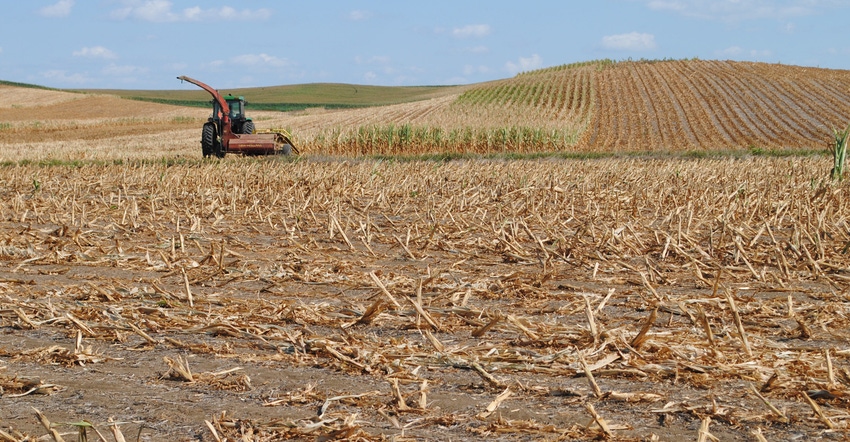August 23, 2022

With much of the state of Nebraska in some level of drought, salvaging drought-stressed corn and sorghum is a challenge.
The primary symptom of drought stress in both corn and sorghum is the inward rolling of leaves. In severe drought conditions, the lower leaves of sorghum may die off, while in corn, the greying of leaf tissue may occur. While these crops have the ability to recover from less severe drought, the current extreme conditions may warrant earlier harvesting for hay silage in order to salvage the crop.
When harvesting drought-stressed corn or sorghum to feed, there are important considerations to keep in mind. Insurance claims should be filed before any action is taken to determine what is permitted according to your policy.
Chemical labels should be checked for any grazing, haying or preharvesting restrictions. Finally, nitrate testing is an affordable way to determine nitrate levels in your crop and help prevent nitrate poisoning in livestock that feed on drought-stressed hay or silage.
With drought, nitrates are likely to accumulate, particularly in the lower stems, so increase cutting height to about 10 to 12 inches. Because of the nitrate potential, grazing of drought-stressed crops can be risky. But severely drought-stressed corn and sorghum can be salvageable with proper preparation and timing of harvest.
Drought corn silage
While drought-stressed corn may look like a lost crop, the value as silage may still be present. Even if corn has no grain, we can expect 80% to 90% of the energy value found in regular corn silage. This energy is in a bit different form, however, and should impact our management decisions.
Instead of starch in grain, energy is still in sugars in the stalk. Because of this, getting a quick and efficient fermentation is critical to capturing as much value as possible before molds, yeast and harmful bacteria can begin chipping away. In these cases, using quality inoculant to speed up fermentation and improve stability is a good idea.
Another value of silage production is the opportunity to lower nitrate risks. While other options like grazing and haying may be a way to use droughty corn, they pose a very high risk of locking in toxic levels of nitrates that may have accumulated in the forage. When ensiled properly, silage fermentation can reduce nitrate levels up to 50%.
Finally, drought-affected corn can be tricky to accurately assess moisture levels on. While it may look overly dry, corn — especially without ears to signal the plant to dry down — can retain high levels of moisture in the stock for well into the fall. Before you cut, take a test strip if possible or hand-sample even dry-looking corn stands to ensure moisture levels are right.
Storing silage
The time and money spent on chopping silage for feed does not go unnoticed. Harvesttime, moisture, processing, chop length, pack density and fermentation efficiency all contribute to the preservation of the nutrients that have been grown all summer.
The correct packing density is one of the most overlooked pieces of the process. A good density goal is to have 14 pounds of dry matter per cubic foot. Pack only a 4- to 6-inch layer at a time and have proper tractor weight.
The 800 Rule can be used to determine how fast a tractor can pack based on weight. Take the weight of the tractor and divide by 800. That will give you how many tons per hour a tractor can pack to have a good density. For example, if the tractor weighs 32,000 pounds and we divide by 800, the result is 40 tons per hour that tractor can pack. The speed of chopping should be determined by the packing speed, not the silage chopper.
The next item is to cover the pile. Even after the silage is packed correctly, air and water can penetrate the outer layers and severely damage the quality and quantity of silage. Additionally, molds, mycotoxins and fungi have a prime place to grow in uncovered silage.
Many studies at Kansas State University have reported a 3% to 40% loss in dry matter from the top 3 feet of silage in uncovered silage bunkers compared to covered. Covering with plastic will give about an 8-to-1 return on investment for the producer.
Silage should be covered as soon as possible with plastic. The standard plastic is still the black- and white-sided 6 mil sheeting. Make sure the edges are sealed and the top has plenty of weight on it.
A good pack and a good cover can reduce losses, increase profit and be safer when facing the pile.
Get more details from your local Nebraska Extension office.
Daniel is a Nebraska Extension educator in Grant. Beckman is a Nebraska Extension educator in Hartington. Schick is a Nebraska Extension educator based in Nance and Boone counties.
UNL Pasture and Forage Minute contributed to this article.
You May Also Like




